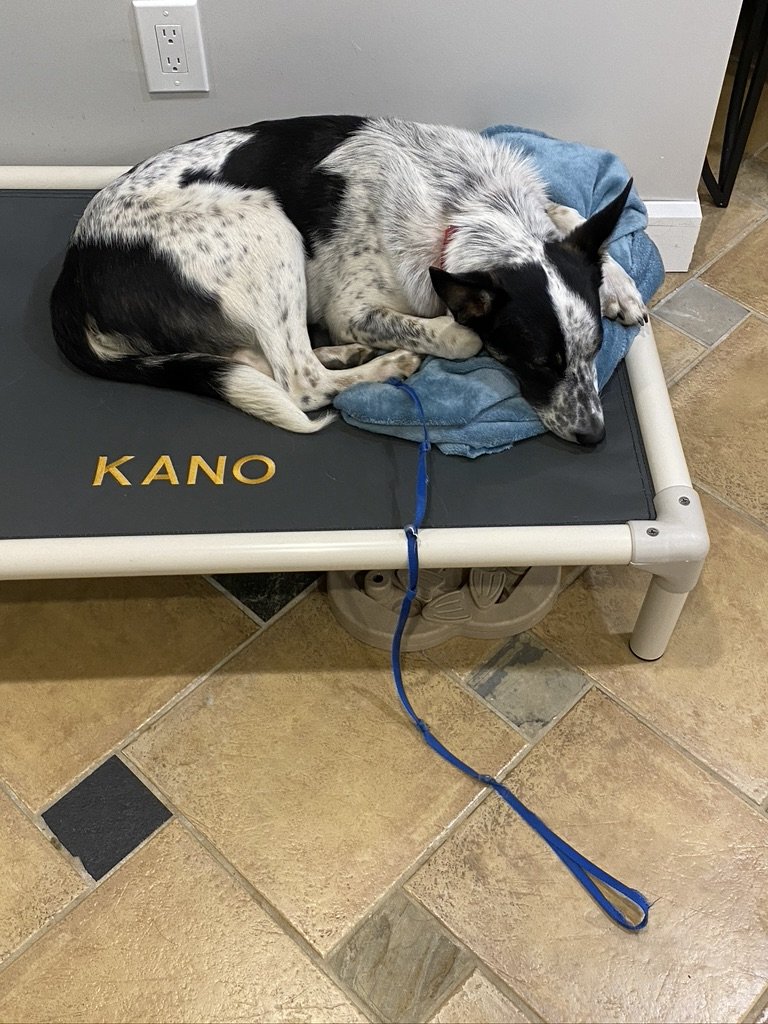Being dragged around by your dog can lead to longterm pain for your joints and your back. It can also damage your dog’s trachea. (Photo: a large brown dog pulling on the leash)
You’ve tried everything.
You have a closet filled with harnesses.
You have a cupboard overflowing with treats.
When your dog sees another dog on a walk, she:
-lunges
-bites the leash
-redirects on you (bites you)
-stands on her hind legs
-screams
-barks
Are you stuck in the cycle where you know you need to walk your dog, but it stresses you out so much that you feel like you can’t do it? (Photo: woman sitting on a chair with her hands covering her face)
At first it was simply embarrassing, but now you fear for your safety and the safety of others on your walks.
You’re worried that you may be pulled into traffic.
You’re afraid that your dog may bite someone.
Here are a few tips that are often overlooked that matter immensely when overcoming leash reactivity.
Your relationship inside your home matters. If your dog doesn’t listen to your commands inside your home, begin working on this immediately. A dog who doesn’t listen inside the home, will not listen outside the home.
A dog who doesn’t listen inside the home, will not listen outside the home (Photo: large black dog sitting on a couch)
2. If your dog walks in front of you during your walks, they are leading the pack and will call the shots (by overreacting.) Teach your dog to heel on the leash and teach your dog the break command. This way of walking is a game changer because it clearly communicates to your dog who is leading, who is following, when it’s time to heel, and when it’s time to sniff and just be a dog. I can’t count the number of reactive dogs I have helped by getting them out of a harness and teaching them to heel.
Heeling looks like this (Photo: woman walking her dog on a road beside sunflowers)
It is way easier on your body (and your dog’s body) than this (Photo: large black dog pulling on the leash)
3. Place command and/or teaching your dog to love their crate teaches them to be calm inside the home and takes away all the time they spend (hours every day) barking at dogs and people to get the heck off of their property and learning that this behaviour works.
Teach your dog to practice calmness inside your home because barking out the window all day is contributing to his leash reactivity (Kano the Cattle Dog practicing placework)
4. Your energy matters. If you’re nervous, tense, fearful, furious, frustrated, etc, your dog will not listen to you. They are hardwired to follow calm, consistent, clear, and fair leaders.
Calmness and confidence come with time and practice. Don’t give up. You can be your dog’s leader. (Photo: calm woman enjoying the sunshine on her face)
5. Dog training is a lifestyle. These commands make living with dogs a pleasure and keep our dogs safe: heel, break, place, crate, leave it, drop it, let’s go, come, and stay. Once you can communicate effectively with your dog the world opens up for both of you.
Dog training is a lifestyle. Practice every day and you’ll get results. (Photo: Harper the Cattle Dog mix working on recall with her owner)
You deserve peaceful walks with your dog.
Schedule your free call now by clicking the take action button.
Have a wonderful weekend, Dog Leaders!
Alyssa
Photos by: Upsplash Images (a large brown dog pulling on the leash,) Ivan Aleksic
@ivalex (woman sitting on a chair with her hands covering her face,) Jack Plant
@jackplantt (large black dog sitting on a couch,) Upsplash Image (woman walking her dog on a road beside sunflowers,) Upsplash Images (large black dog pulling on the leash,) Alyssa Foulkes (Kano the Cattle Dog practicing placework,) Radu Florin
@raduflorin (calm woman enjoying the sunshine on her face,) C. Atkinson (Harper the Cattle Dog mix working on recall with her owner.)








